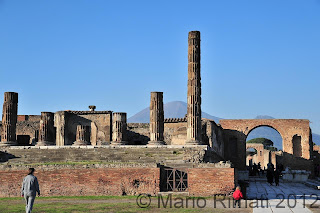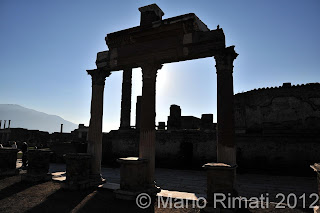Well,
the music nut that I am, on Dec. 30th, 2012 Dani and I travelled to
Pompeii. It was something that I had wanted to do for a long time, ever
since I saw some years ago a Pink Floyd concert which I had bought on DVD. But more on this later.
The
last time I had been there was in 1980 when I came on a backpacking tour of
southern Europe from Canada (a stop-over in Udine to see my relatives then down
to Florence, Rome, Naples, Capri and also Pompeii). I
didn’t remember much of the place as some time has passed since 1980….
We
spent 4 hours walking around and yes, I got my pic taken on the very same spot
where Roger Waters, David Gilmour, Nick Mason and Richard Wright (the last
three I saw live in Rome in the 1990s at the “Cinecitta’” movie studios, the
same where Stallone and Scorsese also shot some their movies) had set up their
equipment. And yes, I even travelled to Pompeii with that famous DVD
which I’m holding in my hands! Yes, only me…
(the video of their opening song in the arena.
http://www.youtube.com/watch? v=uLJ_QVfT_wM)
(the video of their opening song in the arena.
http://www.youtube.com/watch? v=uLJ_QVfT_wM)
What
I basically did was to stand, give or take a few inches, on the very same spot that
Floyd shot their epic “Live at Pompeii, The Director’s Final Cut” concert on October,
1971 (no public was admitted for their rather unique performance). Yeah,
pretty crazy travelling around with a DVD in one’s knapsack, but that’s me (I’ve
been known to travel a total of 1,300 kms, or 812 miles, alone and by car to
see an AC/DC concert in Stuggart, Germany)!

So how did this particular concert take place in an ancient amphitheater? Adrian Maben, the movie’s director, came across the idea to film there after having spoken to Gilmour in London about the idea of making a concert with the band. Maben had been travelling around Italy (as he himself had said: “When you’re in Italy you can’t really miss Pompeii”!). He had been there, like me in 1980, with his girl friend.
He was eating a sandwich in the arena (funny, we did the very same thing). They left and he noticed that he had lost his passport. Around 8 pm, when the place was already closed, he went back to find it and found the arena rather magical. He then threw around the idea to the band members who accepted the rather unique project, and the rest is history (Maben had initially wanted to put their music to famous paintings, but that idea was eventually canned. Other somewhat ideas at the time also included Deep Purple playing in the Taj Mahal)!
No audience was on hand except for some local “urchins” (kids) who managed to get in and who sat off in the corner of the arena. They were 7 years old back then. In 2001 Maben went back and at Pompeii’s tourist office a guy said that he recognized him. Maben thought that was nice. The fellow had actually been one of those kids back in 1971! What incredible memories for that guy.
In
ancient times the arena could seat some 20,000 people, or the entire population
of Pompeii. The arena (it was built around 70 B.C. Some say even as far back as 100 B.C.) was used for gladiatorial
games. In 59 A.D. a “riot” broke out between opposing fans, something
which is very reminiscent of modern-day
soccer games in Italy where there’s certainly NO love lost between fans. The field was banned for the teams’ supporters for 10 years. The ban itself was eventually suspended after the devastating earthquake of 62 A.D.
The entire area of Pompeii is about 66 hectares, of which more than 45 have been excavated. What happened to the area, which has in the background Mount Vesuvius and which is clearly visible too from the archeological area (see pics), was that around 62 A.D. Pompeii was hit by a very violent earthquake. It took about 17 years for things to be rebuilt, until on August 24th, 79 A.D. Vesuvius blew its top. The town was buried under ash and rocks. The town was subjected to three days of a real “inferno” at the hands of Vesuvius.
soccer games in Italy where there’s certainly NO love lost between fans. The field was banned for the teams’ supporters for 10 years. The ban itself was eventually suspended after the devastating earthquake of 62 A.D.
The entire area of Pompeii is about 66 hectares, of which more than 45 have been excavated. What happened to the area, which has in the background Mount Vesuvius and which is clearly visible too from the archeological area (see pics), was that around 62 A.D. Pompeii was hit by a very violent earthquake. It took about 17 years for things to be rebuilt, until on August 24th, 79 A.D. Vesuvius blew its top. The town was buried under ash and rocks. The town was subjected to three days of a real “inferno” at the hands of Vesuvius.
Some
2,000 local inhabitants were killed with many of their bodies still
well-preserved in casts (as can be seen in some of the houses). The town was submerged with up to 18 feet of
ash and rocks. Ironically, the entire
town remained rather well-preserved for some
1,500 years until the 16th century when it had been noticed by an Italian. Finally, in 1748 excavation of the area began under Carlo III, the King of Naples.
1,500 years until the 16th century when it had been noticed by an Italian. Finally, in 1748 excavation of the area began under Carlo III, the King of Naples.
As one can see from the pics, Pompeii is also a photographer’s paradise.
Proper walking shoes or sneakers-hiking boots are the best way to spend a day
there as some of the “streets” are rather uneven (for women: forget those high heels as you’ll only regret
it!).
A
favorite for many tourists is the “Lupanare”, or whorehouse (Lupa in Latin
means “prostitute”). You can enter the “Lupanare” and still see some of the
erotic frescoes on the walls, not to mention the beds too with an adjacent
toilet. The ancient Romans and the folks
in Pompeii, sexually-speaking, had quite the “vivid” imagination, with up to 90 different positions that they were
capable of coming up with! Oral sex was also the call of the day, but women on
men and not vice-versa as back then it was deemed to be “inappropriate” amongst
the ancient Romans.
The
“thermopolias”, or ancient “snack bars”, are also quite common in Pompeii. There are up to 89 of them and they
give you a good idea of how one could stop and have a bite to eat or a warm
drink, just like modern-day cities and/or highways (Pompeii’s
bars are located right on the streets so you can envision what life must have been like back then before Vesuvius unleashed its
devastation). Casts of the town’s victims can also be seen here and there, giving you the idea of the catastrophe that had literally rained down on the poor people.
bars are located right on the streets so you can envision what life must have been like back then before Vesuvius unleashed its
devastation). Casts of the town’s victims can also be seen here and there, giving you the idea of the catastrophe that had literally rained down on the poor people.
Getting to Pompeii isn’t terribly difficult, especially if you arrive in Naples by train (at the “Centrale” station). You look for signs for the “Circumvesuviana Napoli-Sorrento” train under the “Centrale” station (yes, if you want, you can go directly to Sorrento with that train as it passes by Pompeii). The ride out to Pompeii is about 25 minutes. It’ll also take you through some rather “interesting” Neapolitan neighborhoods, such as Torre Annunziata and Torre del Greco, which are both high-density Camorra country (the local mafia).
The train conveniently stops about 200 yards from the entrance of
Pompeii. You walk out from the station, hang right, go past a few
restaurants and there it is. It’s 11 euros to get in, at least that was
the ticket price at the end of 2012. You can get a free map near the ticket office which is
very, very handy as it lists all the sites to see (don’t miss either the Large Theatre). The return to Naples is almost faster: the train we
took didn’t stop at every train station, so we got back to Naples in about 15 minutes.
Car-wise,
from the Pompeii train stop you can see just below the toll-booth station.
I don’t know though where you can park in the area nor just how much the
parking will cost you (with the risk of something also happening to your car,
nothing new really in the Naples area).
The train seems the best and safest way to get there. Personnel are on hand inside Pompeii and they
appear to speak a variety of languages. How much they eventually ask for
a private tour, that I don’t know (one guide was speaking what sounded like perfect
Japanese).
A
rather bad time to go would be in the summer as not only Pompeii fills up with
thousands and thousands of tourists but the place no doubt becomes a “sauna”, reminiscent of
what happened that day when Vesuvius blew its top (and some experts believe
that it’ll once again blow its top and with major catastrophic consequences as
many Neapolitans have illegally built their homes on the side of the
volcano. The subsequent Tsunami that
will follow appears to be even more devastating than Vesuvius itself!).
Also, the so-called “air conditioning” system on the train from Naples to
Pompeii doesn’t look like the greatest, and you certainly DON’T want to be
stuck in a major sweat-box with hundreds of tourists and their gigantic
backpacks either.
It’s opened every day, except on January 1st, May 1st and December 25th. Closing times from December-March are 5 pm (they open at (8.30 am). From April-October the area closes instead at 7.30 pm).
Spring no doubt is also a great time to go as the extreme heat doesn’t set in just yet. We personally found that by going in December and with a magnificent blue sky over our heads it wasn’t warm or cold, just a perfect temperature for walking around such a unique and fascinating site for 4 hours.



















































































